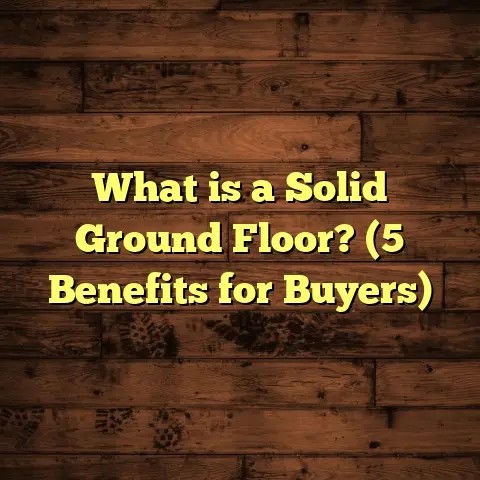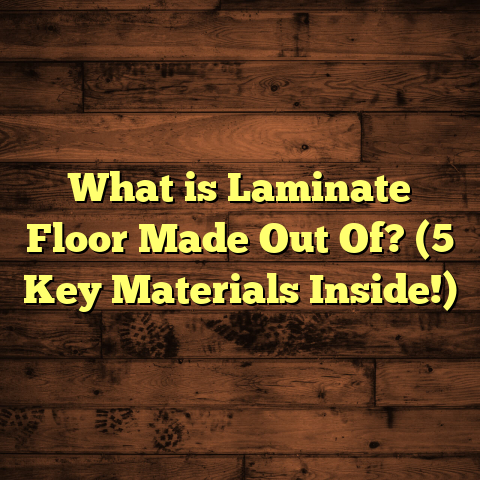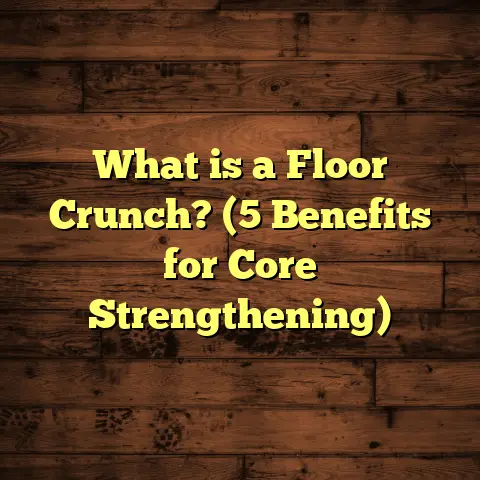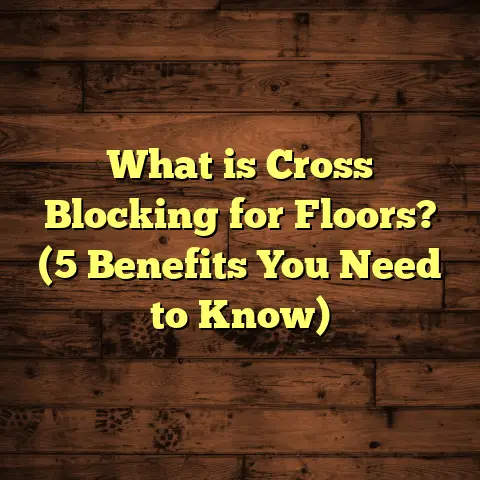What is a Basketball Floor Made Of? (5 Materials You Didn’t Know)
Technology has reshaped so many parts of our lives, and basketball floors are no exception. When I first started working in flooring, I had this simple notion that basketball courts were just straightforward wood surfaces. But very quickly I discovered there’s a ton of engineering and innovation behind these floors. They’re not just about looking good; they have to support athlete safety, enhance performance, and stand up to years of wear and tear.
So, what exactly is a basketball floor made of? You might think it’s all hardwood, but there are different materials with unique properties that affect everything from how the ball bounces to how players move. Some materials you probably already know, but others might surprise you.
I’ve installed and worked with many types of basketball floors over the years. Let me take you through five materials — some classic, some surprising — that go into making basketball floors what they are today.
The Basics: Understanding Basketball Flooring
Let’s start simple: what is a basketball floor? It’s more than just a flat surface for dribbling and shooting. A basketball floor is a carefully engineered platform designed to:
- Absorb impact to reduce injuries
- Provide proper traction so players don’t slip
- Ensure consistent ball bounce
- Resist damage from heavy use and maintenance
At first glance, you might think basketball floors are just wooden planks nailed down. But there’s a lot of science in the materials chosen and how the floor is constructed. For example, did you know that the subfloor — what lies beneath the visible surface — plays a huge role in shock absorption?
When I started in this field, I remember visiting a college gym where they were renovating their basketball floor. They showed me the layers underneath the maple planks: plywood sheets, vapor barriers, and even specialized cushioning pads. Each layer was there for a reason—to protect players’ knees and ankles while maintaining surface stability.
So when we talk about what a basketball floor is made of, it’s really a system of materials working together.
1. Hard Maple Hardwood: The Classic Champion
The Gold Standard for Decades
Hard maple hardwood is synonymous with basketball floors. If you’ve ever watched an NBA game or been inside a college arena, chances are the court underfoot was hard maple.
Why? Because hard maple is dense, strong, and offers excellent shock absorption without sacrificing durability or ball bounce consistency.
I installed my first hard maple gym floor about 15 years ago. The owner told me he chose maple because it lasts longer than other woods and delivers “that pro feel” players demand. Over the years, I’ve seen how well-maintained maple floors can look almost new after decades.
What Makes Maple Ideal?
Maple wood has several properties that make it ideal for basketball courts:
- Density: It’s one of the densest hardwoods used in flooring, around 700 kg/m³.
- Tight Grain: The grain structure is tight and uniform, making for a smooth surface.
- Shock Absorption: It flexes slightly under pressure but rebounds quickly.
- Durability: Resistant to dents and scratches compared to softer woods.
- Ball Bounce: Provides a predictable ball bounce essential for gameplay.
Installation Details
Installing a maple court isn’t just about laying planks down. The process involves multiple steps:
- Subfloor Preparation: Typically plywood sheets are laid over joists or concrete slabs. This subfloor provides stability.
- Moisture Barrier: A vapor barrier is applied to prevent moisture from damaging the wood.
- Maple Plank Installation: The planks, usually ¾ inch thick and 2¼ inches wide, are glued and nailed to the subfloor.
- Sanding & Finishing: The surface is sanded smooth and coated with multiple layers of polyurethane or specialized gym floor finishes.
The finish protects the wood from scuffs and helps maintain traction. It also affects how the ball bounces off the floor.
Data Point: NBA Specifications
The NBA requires its courts to be made from hard maple hardwood with specific construction standards:
- Planks must be ¾ inch thick.
- The floor system includes an engineered subfloor for shock absorption.
- The finish must meet specific slip resistance levels tested by ASTM standards.
Cost Considerations
Hard maple flooring installation can cost between $8 to $12 per square foot, factoring in materials, labor, finishing, and subfloor preparation.
I once worked on a high school project where budget constraints meant we had to balance quality and cost carefully. We decided to use premium maple but optimized labor by scheduling sanding and finishing efficiently. The client was thrilled with how long the floor lasted before needing major repairs.
2. Engineered Wood: The Modern Alternative
What Is Engineered Wood?
Engineered wood flooring consists of multiple layers—usually plywood or high-density fiberboard—topped with a thin veneer of hardwood like maple or oak. This layered construction makes it more stable than solid hardwood.
In my experience installing floors in gyms located in areas with fluctuating humidity levels, engineered wood has been a lifesaver because it resists warping and shrinking much better than solid wood.
Why Use Engineered Wood for Basketball Courts?
Engineered wood offers several advantages:
- Stability: Less prone to movement caused by moisture changes.
- Cost-Effective: Usually less expensive than solid hardwood.
- Installation Speed: Easier and faster to install due to tongue-and-groove systems.
- Environmental Impact: Uses less hardwood overall.
Downsides Compared to Solid Maple
- The wear layer (top veneer) is thinner — usually between 2mm to 6mm.
- Can only be sanded/refinished a limited number of times.
- Some players feel it lacks the same “feel” as solid maple.
Use Cases
Engineered wood floors are common in:
- Community centers
- Schools with budget constraints
- Multi-purpose gyms where humidity varies
Anecdote: Engineered Wood in Action
I remember helping a school district switch from old vinyl floors to engineered wood basketball courts across multiple schools. The district was in a humid region prone to seasonal moisture swings. The engineered wood held up remarkably well over three years with minimal maintenance compared to older solid hardwood floors that had buckled previously.
Installation Process
Similar to solid hardwood but often easier due to prefinished veneers and click-locking systems:
- Subfloor preparation remains critical.
- Layers glued under pressure for stability.
- Finished surface ready quickly (less sanding required).
Cost Breakdown
Prices for engineered basketball floors typically range from $6 to $9 per square foot, depending on veneer thickness and installation complexity.
3. Synthetic Sports Flooring: Polyurethane & Vinyl
What Are Synthetic Floors?
Synthetic sports floors are made from man-made materials like polyurethane or vinyl layered over shock pads or foam bases. They’re designed to mimic wood visually but function differently underfoot.
I’ve installed synthetic floors in gyms that host multiple sports (basketball, volleyball, gymnastics) because they adapt well to varied uses without needing constant refinishing like wood floors.
Types of Synthetic Flooring
- Polyurethane: Durable coats applied over synthetic bases.
- Vinyl Sports Flooring: Flexible sheets or tiles that can imitate wood grain.
- Rubberized Flooring: Offers great impact absorption but less common for competitive basketball courts.
Benefits
- Quick installation
- Low maintenance (no sanding needed)
- Excellent resistance to stains and moisture
- Can be used indoors/outdoors
Drawbacks
- Different ball bounce characteristics—not as lively as wood.
- Some athletes find them too soft or “spongy.”
- May not meet professional league standards for official games.
Case Study: Multi-use Facility Flooring
I once installed synthetic polyurethane flooring in a community center gym that hosted basketball games alongside dance classes and aerobics sessions. The floor’s ability to handle heavy foot traffic without damage amazed everyone, though some basketball players preferred playing on traditional hardwood during tournaments.
Installation Notes
Installation involves:
- Laying shock pad or foam base
- Applying polyurethane or rolling out vinyl sheets
- Sealing edges for durability
Cost Insight
Synthetic floors cost between $4 and $8 per square foot depending on material quality and base padding thickness.
4. Bamboo Flooring: The Eco-Friendly Player
Bamboo Enters the Court
Bamboo has become popular in flooring as an environmentally friendly alternative to traditional hardwoods. I was curious when I first heard about bamboo being used for basketball courts because it’s not native everywhere and has different mechanical properties than hardwoods.
What Makes Bamboo Suitable?
Bamboo grows much faster than hardwood trees—some species mature in five years—making it highly renewable. It’s also surprisingly hard; strand-woven bamboo can be harder than hard maple.
From an environmental perspective, choosing bamboo means less deforestation impact.
Performance Characteristics
Bamboo flooring offers:
- Strong durability
- Good shock absorption when installed with appropriate underlayment
- Unique aesthetic with light color and distinctive grain patterns
Real-Life Example: College Gym Bamboo Floor
A university I worked with wanted to showcase sustainability in their building upgrades. They chose bamboo for their basketball court floor. Players enjoyed its firm feel but noticed it was slightly less “springy” than maple.
The maintenance crew reported the floor required sealing every few years but was otherwise resilient to scratches and dents.
Challenges
Bamboo is sensitive to moisture if not properly sealed. Improper installation can lead to cupping or warping.
Also, because it’s less common in gym flooring, fewer contractors have experience installing it correctly.
Pricing Details
Bamboo floors for sports use typically cost around $7 to $10 per square foot including installation.
5. Cork Flooring: The Unexpected Cushion
Cork? Really?
Cork might sound unusual as a basketball floor material, but its natural cushioning qualities make it an intriguing option for practice gyms or multi-purpose fitness centers.
I first encountered cork flooring while renovating an urban fitness studio where noise reduction was critical due to nearby apartments.
Why Cork Works
Cork comes from tree bark harvested sustainably without cutting down trees. It has tiny air pockets that absorb shock and reduce noise significantly.
Players reported less joint fatigue after long sessions compared to traditional hardwood floors.
Pros & Cons of Cork Floors
Pros:
- Excellent impact absorption
- Noise reduction benefits
- Environmentally sustainable
- Warm touch underfoot
Cons:
- Softer surface prone to dents & scratches
- Requires sealing every couple of years
- Not suited for high-intensity competitive play due to durability limits
Installation & Maintenance Insights
Cork flooring involves installing sheets or tiles over cushioning underlayment with sealants applied on top for moisture resistance.
Maintenance includes gentle cleaning and reapplication of sealants every few years.
Cost Range
Cork floors generally fall between $5 and $9 per square foot installed — affordable compared to hardwood options but with different performance expectations.
Exploring Subfloor Systems: The Unsung Hero of Basketball Floors
One topic I often discuss with clients is how crucial the subfloor system is beneath any basketball surface.
A great basketball floor isn’t just about the top layer—without proper shock absorption and stability underneath, even the best surface won’t perform well or protect players adequately.
Common Subfloor Types
- Plywood Over Concrete: Most common approach; plywood sheets over vapor barriers on concrete slabs.
- Suspended Wood Subfloors: Built on joists allowing slight flex for extra shock absorption.
- Rubber Pad Systems: Incorporate rubber mats or foam pads for enhanced cushioning.
- Spring Floors: Specialized systems using springs or elastomeric materials for professional-level shock absorption (used mostly in elite arenas).
I remember working on an NBA arena renovation where they replaced a plywood subfloor with an advanced spring system designed specifically to reduce player fatigue during long seasons.
How FloorTally Helps Me Manage Project Costs
Balancing budget while selecting quality materials can get complicated fast when working on basketball floors—especially if you’re comparing options like maple vs bamboo vs synthetic surfaces.
That’s why I use tools like FloorTally regularly during my projects. It lets me input local material prices, labor costs, waste percentages, and finishes all in one place.
This saves me time hunting down quotes from multiple vendors separately. Plus, it lets me generate detailed reports showing clients realistic costs upfront so there are no surprises later on.
For example, when helping a school district decide between engineered wood or synthetic vinyl floors for their gyms, FloorTally’s side-by-side cost breakdown made decision-making straightforward. Clients appreciated seeing how small price differences could add up over thousands of square feet.
More Materials & Innovations Worth Mentioning
Though these five materials cover most basketball floors today, other innovations have caught my eye:
Rubber Sports Flooring Variants
While rubber is more common in general sports facilities or weight rooms, some gyms experiment with rubberized basketball floors aiming for extreme shock absorption though with trade-offs in ball bounce consistency.
Recycled Materials & Composites
Some manufacturers now produce sports flooring made partly from recycled plastics combined with wood fibers or rubber crumbs—offering sustainable options while maintaining performance standards.
Coatings & Finishes Technology
New finishes incorporating antimicrobial agents or enhanced UV protection help maintain court appearance longer even with heavy use and cleaning cycles—a big deal in school gyms during cold/flu seasons!
My Personal Reflections on Basketball Flooring Choices
Over my years installing all these types of floors, I’ve learned there’s no one-size-fits-all answer. Your choice depends heavily on:
- How often the court will be used
- Level of competition (professional vs recreational)
- Climate conditions affecting moisture levels
- Budget constraints
- Environmental goals (sustainability)
I once advised a client who initially wanted synthetic flooring due to budget but convinced them to stretch for maple after explaining its long-term durability and player safety benefits. That floor still looks great after a decade with only routine maintenance.
Conversely, I’ve seen schools happily use engineered wood or vinyl because they matched their usage needs perfectly without overspending upfront.
Questions You Might Be Wondering About
How often should basketball floors be refinished?
For hardwood floors like maple, refinishing every 5–7 years is typical depending on use intensity. Engineered wood has fewer refinishing options; synthetic floors usually don’t need sanding but may need recoating occasionally.
Can I install a basketball floor outdoors?
Outdoors is tricky due to weather exposure. Synthetic vinyl or specialized outdoor sports surfaces work better than wood outside because they resist moisture better.
What about maintenance?
Hardwood floors require regular cleaning with pH-neutral cleaners and periodic waxing/sealing. Synthetic floors are easier—just regular sweeping/mopping without harsh chemicals.
Final Thoughts: More Than Just Wood Underfoot
Next time you step onto a basketball court, take a moment to appreciate what’s under your feet — all those layers of carefully chosen materials designed not only for performance but also for player safety and longevity.
From traditional hard maple hardwood courts that have defined professional basketball for generations to innovative bamboo or eco-friendly cork surfaces that reflect modern concerns — basketball floors are fascinating blends of craftsmanship and technology.
Do you have questions about choosing or caring for your basketball floor? Or maybe you’ve played on some unusual court surfaces? I’d love to hear about your experiences!





